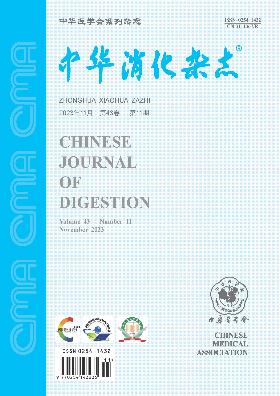Preliminary study on abundance and diversity of microbiota in liver tissues of patients with autoimmune liver disease
引用次数: 0
Abstract
Objective To provide clues for the study on the mechanism of autoimmune liver disease (AILD) by exploring the existence of specific bacteria in liver tissues of AILD patients. Methods From August 2017 to August 2018, at Department of Gastroenterology and Hepatology, Tianjin Medical University General Hospital, a total of 12 patients diagnosed as AILD (four autoimmune hepatitis (AIH), four primary biliary cirrhosis (PBC) and four PBC-AIH overlap syndrome (OS)) and four patients with hepatic cyst (control group) were enrolled and all the patients underwent liver biopsy. 16S rRNA gene sequencing was carried out in the obtained aseptic liver tissues. Linear discriminant analysis effect size was used to find out the specific bacteria. Spearman correlation analysis was performed to analyze the correlation between the liver microbiota and the disease. The metabolic function of the 16S rRNA gene sequences was also predicted. Results Bacteria were detected in the liver tissues of all the 16 patients. At the species level, the abundance of Planococcus rifietoensis of AIH group was 0.100%, which was higher than those of other three groups (0), and the difference was statistically significant (linear discriminant analysis (LDA)=3.31, P=0.034). The abundance of Anoxybacillus flavithermus of PBC group was 0.200%, which was higher than those of other three groups (0.100%), and the difference was statistically significant (LDA=3.34, P=0.014). The abundance of Pseudomonas aeruginosa PAO1, Bacillus firmus, Brevibacillus agri, Acinetobacter baumannii, Sphingomonas zeae and Salmonella enterica were significantly negatively correlated with serum level of γ-glutamyl transferase (r=-0.68, -0.68, -0.67, -0.68, -0.68 and -0.66, all P<0.01). Compared with that of the hepatic cyst group, the lipid metabolism of AILD patients decreased. The levels of serum low density lipoprotein and total cholesterol were significantly negatively correlated with the biosynthesis of unsaturated fatty acids (r=-0.55 and -0.65, both P<0.05). Conclusions There exist specific bacteria in the liver tissues of AIH and PBC groups. The liver microbiota which is closely related with the pathogenesis of AILD might be a potential therapeutic target and diagnostic biomarker. Key words: Autoimmune liver disease; Liver tissues; 16S rRNA gene sequencing; Microbiota richness; Diversity自身免疫性肝病患者肝组织微生物群丰度和多样性的初步研究
目的探讨自身免疫性肝病(AILD)患者肝脏组织中特异性细菌的存在,为研究自身免疫性肝病(AILD)发病机制提供线索。方法选取2017年8月至2018年8月天津医科大学总医院消化内科肝病科诊断为AILD的患者12例(自身免疫性肝炎(AIH) 4例、原发性胆汁性肝硬化(PBC) 4例、PBC-AIH重叠综合征(OS) 4例)和肝囊肿患者4例(对照组),所有患者均行肝活检。对所得无菌肝组织进行16S rRNA基因测序。采用线性判别分析效应量,找出特定菌群。采用Spearman相关分析分析肝脏微生物群与疾病的相关性。对16S rRNA基因序列的代谢功能进行了预测。结果16例患者肝脏组织均检出细菌。在种水平上,AIH组的利菲托平球菌丰度为0.100%,高于其他3组(0),差异有统计学意义(线性判别分析(LDA)=3.31, P=0.034)。PBC组黄热无氧杆菌丰度为0.200%,高于其他3组(0.100%),差异有统计学意义(LDA=3.34, P=0.014)。铜绿假单胞菌PAO1、硬芽孢杆菌、农业短芽孢杆菌、鲍曼不动杆菌、玉米膜单胞菌和肠沙门氏菌的丰度与血清γ-谷氨酰转移酶水平呈极显著负相关(r=-0.68、-0.68、-0.67、-0.68、-0.66,P均<0.01)。与肝囊肿组相比,AILD患者脂质代谢降低。血清低密度脂蛋白和总胆固醇水平与不饱和脂肪酸生物合成呈显著负相关(r=-0.55和-0.65,P均<0.05)。结论AIH组和PBC组肝脏组织中存在特异性细菌。肝脏微生物群与AILD的发病机制密切相关,可能成为潜在的治疗靶点和诊断标志物。关键词:自身免疫性肝病;肝组织;16S rRNA基因测序;微生物群丰富;多样性
本文章由计算机程序翻译,如有差异,请以英文原文为准。
求助全文
约1分钟内获得全文
求助全文

 求助内容:
求助内容: 应助结果提醒方式:
应助结果提醒方式:


